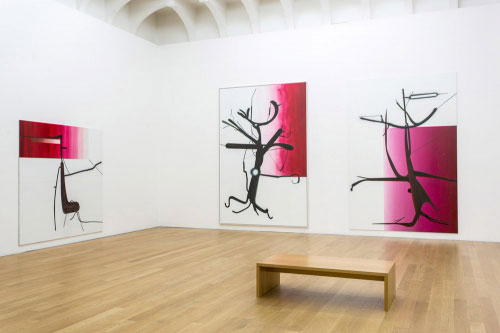
‘Alarming’ … a detail from Untitled (Baum 44), 2015, by Albert Oehlen. Photograph: Stefan Rohner/Courtesy Gagosian Gallery
Recently, Sean O’Hagan at The Guardian interviewed Albert Oehlen about his Gagosian Gallery exhibition in Mayfair. O’Hagan’s interview explores the artist’s skeletal tree paintings, but also is an examination of the artist himself. Oehlen’s interpretations of trees, being abstract and minimalistic in nature, are painted on the artists’ substrate of choice, Dibond aluminum composite.
 Oehlen explains in O’Hagan’s interview, “I like the stiffness. It has this modern technological feel to it, and it’s actually much easier to paint on than canvas. I wasn’t looking for another surface, I just tried it one day and liked it.”
Oehlen explains in O’Hagan’s interview, “I like the stiffness. It has this modern technological feel to it, and it’s actually much easier to paint on than canvas. I wasn’t looking for another surface, I just tried it one day and liked it.”
Oehlen is an incredibly interesting subject in himself, struggling conceptually to make art that is entertaining, but also utilizing an attitude of ambiguity related to the meanings of his works.
 He’s sort of relaxed, doesn’t take himself or his work too seriously, even created a series of what he called “bad paintings” during the Junge Wilde/Wild Youth art movement in Germany. This in fact gave the artist his “punk” reputation, although he didn’t consider himself one [a punk] at the time. He breaks traditionally artist boundaries by admitting he “didn’t care” about color for a long time, in the interview.
He’s sort of relaxed, doesn’t take himself or his work too seriously, even created a series of what he called “bad paintings” during the Junge Wilde/Wild Youth art movement in Germany. This in fact gave the artist his “punk” reputation, although he didn’t consider himself one [a punk] at the time. He breaks traditionally artist boundaries by admitting he “didn’t care” about color for a long time, in the interview.
His trees, the progressive work of decades, as he describes them, “They are more simple and more complicated now,” he says. “When you place those black lines against a magenta background, something alarming happens. Magenta is a hysterical colour somehow. To me, they look like psychopathic trees – psychopathic humantrees.”
Oehlen then makes an interesting revelation that answers any art enthusiasts notions of the meaning of works by posthumous artists, where he explains the meaning of his works as unimportant, people will determine meanings on their own; he just wants to continue experimenting and making new works.
information courtesy of The Guardian
photography © Stefan Rohner, courtesy of Gagosian Gallery

